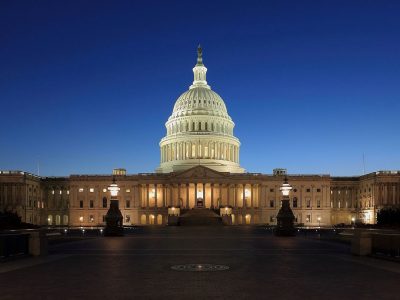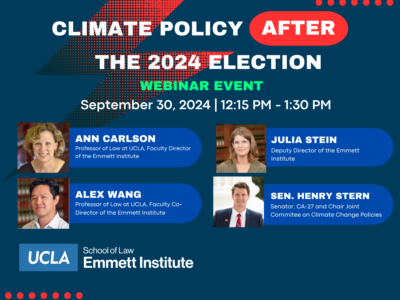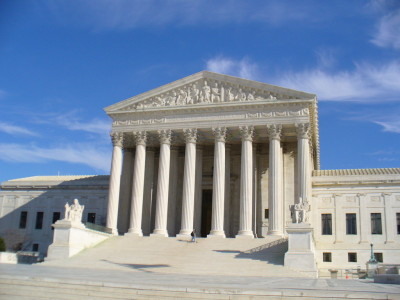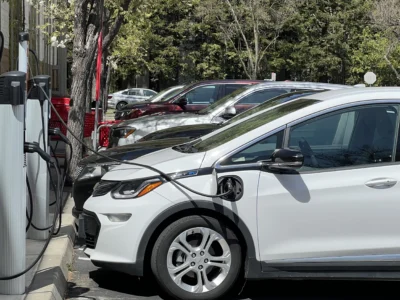Clean Air Act
EPA Grants California’s Waivers for Clean Cars and Clean Trucks
By finally granting the Advanced Clean Car II waiver, the agency just undercut Trump’s planned attack on electric vehicles.
EPA just made the incoming Trump Administration’s efforts to stop the move toward clean, zero emission vehicles a whole lot tougher. And ironically, the U.S. Supreme Court’s controversial decision overturning deference to agency actions, Loper Bright v Raimondo, may help California in any litigation over the legitimacy of the waiver request. EPA finally granted California …
Continue reading “EPA Grants California’s Waivers for Clean Cars and Clean Trucks”
CONTINUE READINGYes, Virginia, There ARE Federal Climate Laws.
Contrary to myth, Congress has actually passed laws relating directly to climate change.
It’s a common misconception that Congress has never passed any climate change legislation. But Congresshas passed at least laws regulating two powerful greenhouse gases, as well as a series of other laws stretching back almost forty years. The story begins under President Nixon and extends into the Biden years with the multi-billion dollar Inflation Reduction Act.
CONTINUE READINGPresident-Elect Trump vs. California: What Lies Ahead?
Will It Be Environmental Law & Policy Deja Vu All Over Again? Or Even Worse?
Californians who care about the environment likely–and justifiably–feel whipsawed this week. Former President Trump (#45) has re-emerged as President-elect Trump (#47), interrupted by the intervening four years of the Biden-Harris presidential administration. (Actually, this presidential whipsaw has been going on for decades: think Bush Sr.-Clinton-Bush Jr.-Obama-Trump-Biden-Trump redux.) In general, California’s progressive environmental laws and policies …
Continue reading “President-Elect Trump vs. California: What Lies Ahead?”
CONTINUE READINGSix Sleeper Proposals in Project 2025
Project 2025 isn’t just its headline proposals. It’s a thorough, detailed attack on environmental protection.
Project 2025’s proposals involve reduced protection for endangered species, eliminating energy efficiency rules, blocking new transmission lines, changing electricity regulation to favor fossil fuels, weakening air pollution rules, and encouraging sale of gas guzzlers. There’s some pious talk about protecting the environment, but every proposal calls for weakening environmental protections.
CONTINUE READINGThe Election, Vehicle Emissions, and State Climate Plans
If the California car waiver survives a possible Trump presidency, we may have the overruling of Chevron to thank.
If one single thing about the election keeps state environmental regulators up at night, it’s how much a Trump victory would impact their ability to cut transportation emissions. As it turns out, Trump’s leverage would be reduced, ironically enough, because his conservative Supreme Court appointees helped overrule the Chevron doctrine. Trump can still cause a …
Continue reading “The Election, Vehicle Emissions, and State Climate Plans”
CONTINUE READINGClimate Policy After the 2024 Election
In this UCLA Emmett Institute webinar, panelists discussed the climate implications of the 2024 election from the state, national, and international perspective.
Climate certainty. Legislative action. Whipsaw regulations. An exodus of civil servants. Chinese leadership despite being the world’s largest emitter. Those are a few of the possible outcomes of the Nov. 5 presidential election, according to our panelists. More than in any previous election, the two major candidates’ track records on environmental policies are well-established and …
Continue reading “Climate Policy After the 2024 Election”
CONTINUE READINGThe Supreme Court & Interstate Pollution
It was puzzling that the Court agreed to hear the case. How has it ruled? And why?
Months ago, the Supreme Court agreed to hear an “emergency” request to stay EPA’s new rule regulating interstate air pollution. Like most observers, I was puzzled that the Court was bothering with the case before the D.C. Circuit even had a chance to consider the merits of the challenges. Months later, the Court has finally …
Continue reading “The Supreme Court & Interstate Pollution”
CONTINUE READINGThe Ten Most Important U.S. Environmental Laws
Some of the choices may surprise you.
What are America’s most important environmental laws? Some are familiar, such as the federal air and water pollution laws, and the Endangered Species Act. But there are other people rarely hear about — even in environmental law courses — but have done a lot to protect the environment.
CONTINUE READINGEPA’s New Power Plant Rules Have Dropped. What Happens Next?
Media battles. Lawsuits. Stay requests. And political mayhem.
The release of Biden’s new climate regulations for power plants will unleash a maelstrom of legal and political battles. One key question: Will the Supreme Court short circuit the litigation process by staying the rules.
CONTINUE READINGThe New EPA Car Rule Doesn’t Violate the Major Questions Doctrine
They both relate to climate, but West Virginia v. EPA involved a very different regulation raising very different issues.
In West Virginia v. EPA, the Supreme Court struck down the Obama-era Clean Power Plan. The heart of the ruling was that EPA had engaged in a power grab, basing an unprecedented expansion of its regulatory authority on an obscure provision of the statute. Conservative groups have claimed since then that virtually every government regulation …
Continue reading “The New EPA Car Rule Doesn’t Violate the Major Questions Doctrine”
CONTINUE READING










